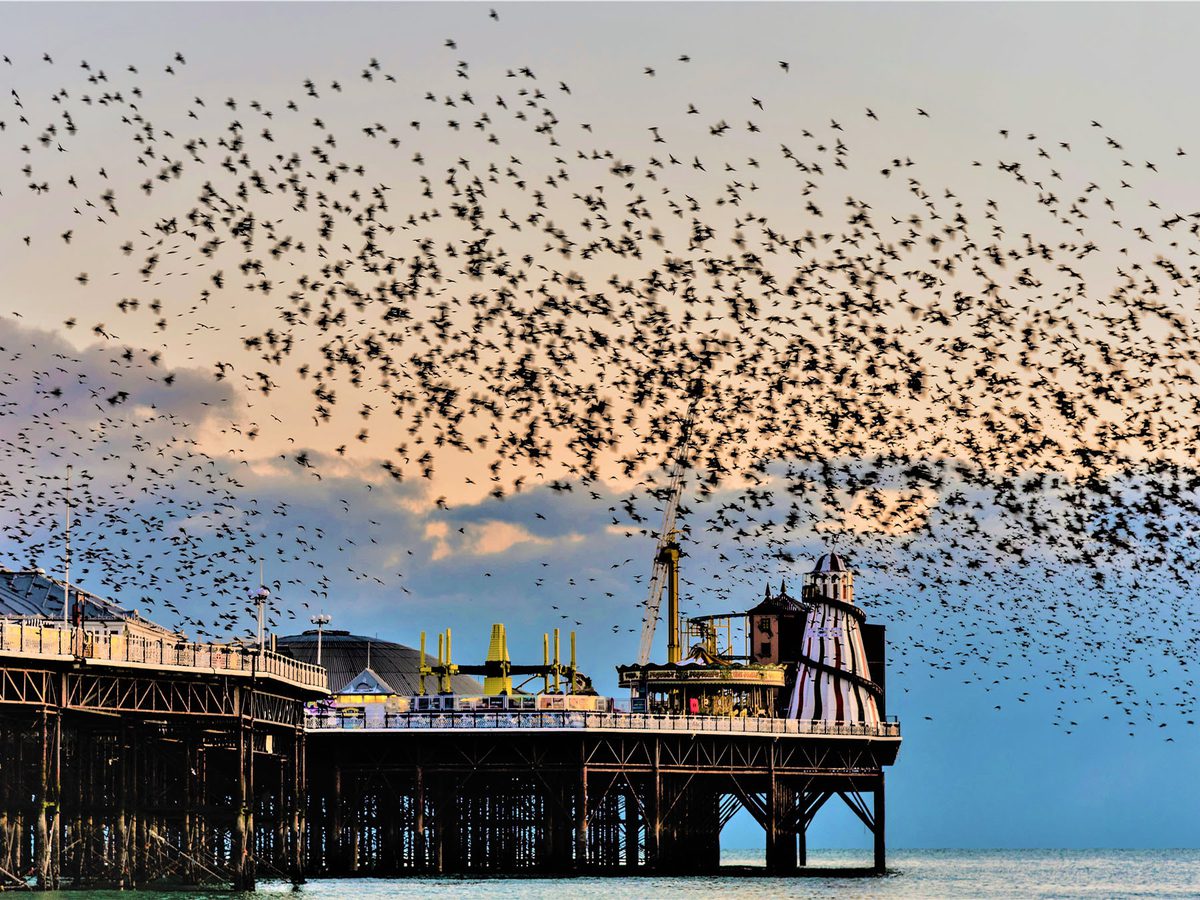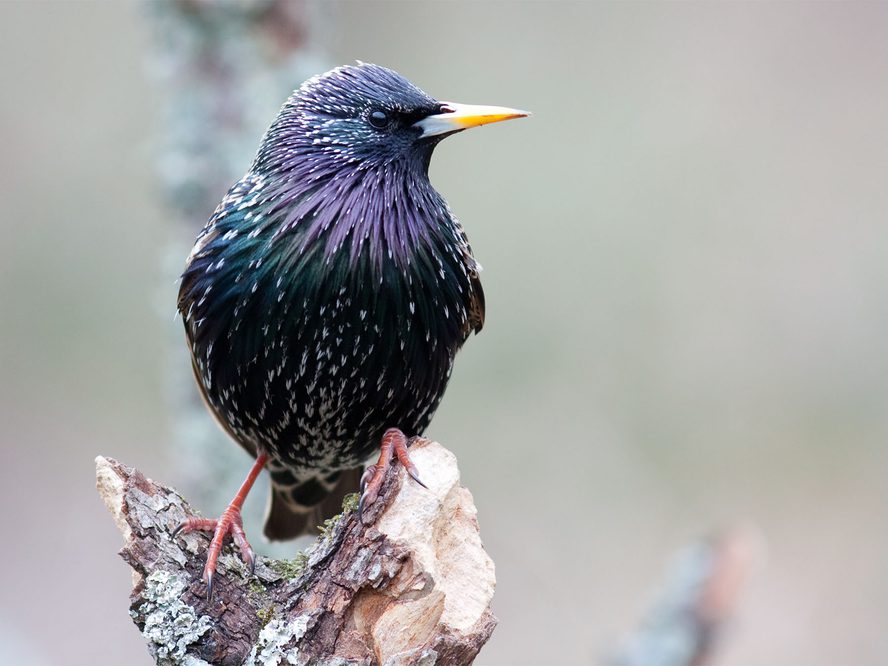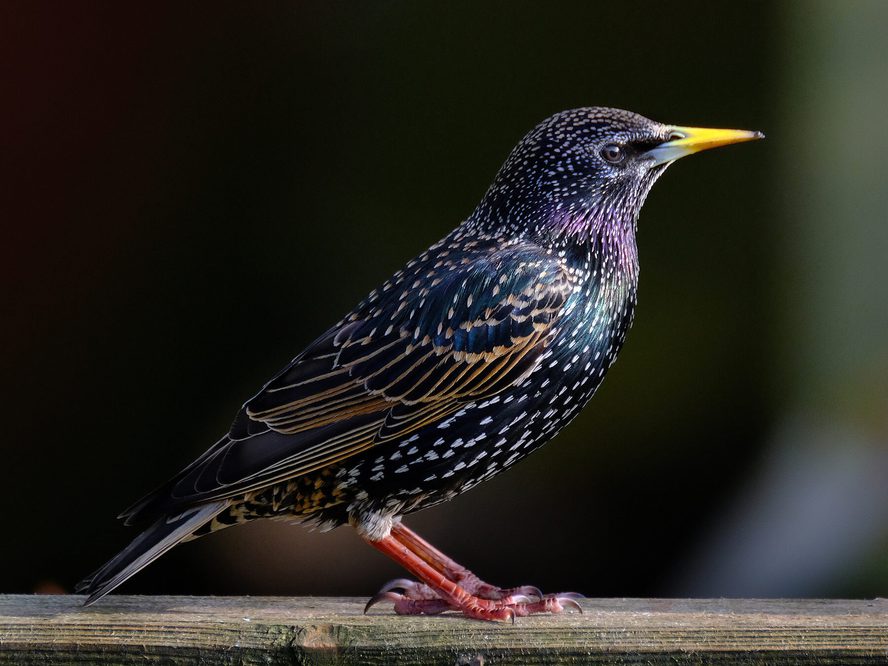Jump to Section
Starling Murmurations in the UK: Best Places to See, When + FAQs
Last updated: 16 November 2023

One of nature’s most impressive spectacles, murmurations of starlings in perfect synchronisation across the sky swirling into formations are an unforgettable sight. Flocks of hundreds of birds gather to fly in faultless formation, with the largest murmuration ever recorded numbering around 6 million birds.
Best Times of Year to Witness Murmurations
Autumn and winter are the prime seasons for starling murmuration observations, with autumn roosts usually gathering from September onwards. These reach a peak from November to January and continue until March.
Starling numbers in the UK swell dramatically with the arrival of migrant birds ahead of each winter. Most of our temporary visitors have arrived by November, with vast communal nightly roosts occurring until March when non-native starlings begin to return to their breeding grounds.
Typical Times of Day for Murmurations
Dusk and dawn are the magic hours when starlings typically display their aerial acrobatics.
These look particularly mesmerising against sunset skies. Ahead of settling down at their nightly roost sites, huge flocks congregate and fly together in unison, swooping through the sky and merging into a series of shapes and patterns. Activity can begin around an hour and a half before the sun sets.
Starlings roost together every night during the autumn and winter, but spectacular murmuration displays are not guaranteed, and we are not entirely sure why some nights a full, breathtaking show is offered, while other evenings birds may simply peel off in smaller groups to head straight to their roosting spots.
Weather doesn’t seem to be a major factor, with murmurations occurring in the rain, as well as in strong winds, so it really does appear to be potluck from one night to another.
On cloudy, dull evenings, starlings may gather to roost earlier than on brighter evenings with clear skies.

Shapwick Heath Nature Reserve, Somerset - Dusk and dawn are the magic hours when starlings typically display their aerial acrobatics
UK’s Top Starling Murmuration Locations
Coastal areas are particularly well known for murmurations and offer unrivalled photo opportunities over the sea, with the most dramatic and memorable settings. Brighton’s West Pier hosts nightly murmurations of tens of thousands of starlings and Aberystwyth Pier is among the top hotspots for sightings in Wales.
Urban areas are another likely spot to catch sight of Starling murmuration, particularly in city parks where starlings are known to congregate and forage during the day. Eastbourne, Bognor Regis, Hastings, and Chichester are fairly large residential centres that all have reported regular sizeable starling murmurations. The rooftops of Gretna Green also frequently have large murmurations passing overhead in winter months.
Countryside meadows and open fields serve as perfect stages for nightly starling roosts to gather. Shapwick Heath in Somerset hosts what are thought to be one of the UK’s largest starling murmurations.

Palace Pier, Brighton - Coastal areas are particularly well known for starling murmurations
The Ideal Murmuration-Watching Experience
The best advice offered to those wishing to catch a glimpse of a Starling murmuration is to wrap up warm, arrive at the observation point at least an hour ahead of sunset, and be prepared to sit and wait for the spectacle to unfold. No two murmurations are the same, and it can take a lot of patience and sitting around for several evenings before you strike gold.
Murmurations can be observed in all weathers, although a more comfortable experience would definitely be on a dry, mild evening. One often overlooked tip is that murmurations are not limited to dusk: they happen at dawn too, so it might be worth an early start to catch a glimpse of a pre-sunrise display.
Some sites that are associated with regular murmuration sightings offer signage that identifies prime vantage points, as well as binocular hire and nearby parking.
Photography and Murmurations
Capturing the sheer awesomeness of a starling murmuration on camera can be a particularly tricky skill to master, especially bearing in mind the failing light conditions at the time of day they occur. One tip is to use a wide-angle or mid-telephoto lens to capture the entire flock and zoom in on the detail at a later stage.
There are a number of principles to keep in mind when photographing wildlife to ensure the experience causes minimal disruption to the surrounding area and its natural residents. Don’t use flash photography and limit any artificial light.
Do not approach wild birds or their roosting and nesting spots too closely, and be respectful of others in the same area also hoping to capture the experience on their own cameras.

Somerset Levels - Capturing the sheer awesomeness of a starling murmuration on camera can be a particularly tricky skill to master
Conservation and Respect
Many spots that are identified as prime viewing areas for murmurations are located within conservation areas and nature reserves. Vantage points are identified that are a safe distance from the roosting sites themselves so as to cause minimal disruption to the birds in their natural environment. Stick to public land and do not be tempted to trespass onto private property!
As with all birdwatching and wildlife observations, it’s crucial to remember to respect the natural habitat and avoid any damage, disruption, and excessive noise. If using a torch to find your way back to a car park or exit point afterward, be mindful of not dazzling any other wildlife nearby.
Extending the Trip
Several of the UK’s foremost murmuration spots are located within nature reserves and designated conservation areas, at wetland sites, and in coastal parks.
Visiting these reserves in the daytime can be just as rewarding, so combining your trip may bring you extra sightings of new bird species and a wealth of bonus photo opportunities. Some sites offer guided walks during the daytime, which can provide handy tips about ideal spots for murmuration sightings once night falls.
Tips for First-Time Observers
It’s important to remember that murmurations are unpredictable natural phenomena and cannot ever be guaranteed, so be prepared to not be rewarded the first time you set off in the hope of catching sight of one.
A clear crisp night may offer the best chances as well as the best views, and it’s not important to take any special equipment with you, as murmurations are clearly visible in the sky without binoculars.
If your first attempt at an observation is not successful, do not lose hope, because these are nightly occurrences and your patience will surely be rewarded at some point.

Marazion Marsh RSPB Reserve, Cornwall - Many spots that are identified as prime viewing areas for murmurations are located within conservation areas and nature reserves
FAQs
When is the peak murmuration season in the UK?
Once the breeding season ends, larger flocks of starlings begin to gather across the UK, joined by visitors from northern Europe arriving to spend the winter in our milder climate. Murmurations can be seen from September onwards, but do not really reach a peak until November to January, and then continue until March.
Are there local guides available for murmuration watching?
Many murmuration hotspots offer guided evening walks and tours that you can join to observe the starlings’ nightly roosting rituals, for example on the Somerset Levels and Avalon Marshes. But don’t worry if you’d rather go it alone, as you do not need to join an official tour or group to enjoy these sights, and at some locations, facilities are minimal.
Summary
Seeing mind-bending photos or video footage online may be your first encounter with a starling murmuration but there is nothing quite as spectacular as witnessing one firsthand.
With a mix of patience and luck, and being in the right place at the right time, there’s every likelihood that you will soon enough have your own memories of one of nature’s most incredible aerobatic displays.
Wrap up warm, head to a murmuration hotspot look to the skies with your camera at the ready, and stick to the paths or routes indicated for the best and least disruptive experience.







